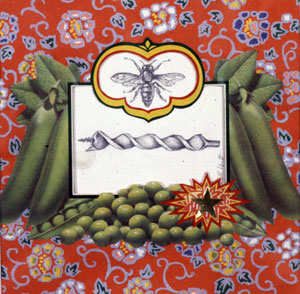|
Merrilee
Hortt
Small Vanities: Works on Paper 1997 – 2004
Carson City Courthouse Gallery
February 17 – May 23, 2005
. . .
The Attentive Art of Merrilee Hortt
Essay
by Gregrory Crosby
Curators’ note: In conjunction with “Merrilee Hortt: Small
Vanities,” the Capital City Arts Initiative is delighted to present
the essay below by Gregory Crosby. Mr. Crosby is an arts writer and cultural
critic, currently living in New York City. His writing for a broad range
of Las Vegas publications has been instrumental in helping fuel and promote
the cultural renaissance of what locals in the Las Vegas art scene have
appropriately dubbed “The Radiant City”. Our thanks go to
Mr. Crosby for his contribution to “Small Vanities”.
The stormy head of the Bride of Frankenstein hovers above a small group
of zebras on the move, like a weird Gothic cloud above the veldt. “Winged
Victory” stands in its headless splendor while regarded by a flamingo,
a crane, a seagull. Tiny clowns take pratfalls before a towering ridge
of beer bottles. Three twisting candles hold themselves upright casting
long shadows in search of a birthday cake. Lips align themselves with
a wood screw, or a contortionist aligns himself with a pair of scissors,
or a bullfrog with a revolver, each in an elaborate patterned proscenium
of peach halves or string beans. It must mean something—literally
so in the case of the latter images, dubbed “It Must Mean Something
(Gun)” or “It Must Mean Something (Profile).” And
it does: it means that someone is paying attention.
That’s what artists do, of course, a faculty so obvious as to seem
almost counter-intuitive. When much of contemporary art seems mired in
a deliberate vagueness—casual, glancing, insipid in either concept
or execution—it’s the artist who simply finds the salient
or unexpected detail and vividly renders it that most captures our own
attention. The artist who makes grand gestures out of very small ones,
and does it without ever seeming grand herself. Having experienced Merrilee
Hortt’s works on paper for over a decade, I’m always simultaneously
surprised and knowingly satisfied by her attentiveness, and the skill
with which she transmutes it into pictures that are rich, complex and
mysterious without ever becoming unnecessarily showy or cheaply shocking.
The kind of shock Hortt trades in is a quiet one: the shock of recognition,
coupled with a split-second sense that you have no idea what you’re
looking at, even though the object is clearly a fork, its twines casting
sinister (why sinister?) shadows. In her “Small Vanities” series
of drawings, each object—a rose, a bicycle horn, a swatch of fabric—is
both itself and something more. Somehow Hortt captures the varied associations,
emotional and rhetorical, that abound in everyday things. We would see
these associations bubble up into our minds constantly, if we ever stopped
long enough to regard a pair of salt and pepper shakers or a fortune
cookie the way Merrilee Hortt does. We would revel for a moment in our
inescapable materialism—our attachments to the little things that
make the world not just easier or better, but in a sense possible. The
cliché claims its no good to be hung up on mere things, but
things are the pegs we hang our bodies and senses on: the physical
world that
without which a spiritual dimension would be meaningless.
Hortt is well attuned to this, and deftly re-focuses the viewer’s
attention on the connections between the world around us and ourselves,
connections that are so matter-of-course they might as well be breathing.
And like breathing, which becomes quietly miraculous when you pause and
focus on your own lungs, expanding and contracting, Hortt makes little
miracles out of juxtapositions of sight and sensation, as in “Self
Portrait as a Teal Dress” and “Self Portrait as a Blue Dress.” Here,
Merrilee Hortt pulls and squeezes her own face until it resembles the
folds in fabric: flesh becomes fashion and vice versa. Or she draws attention
to language and its intentions and representations: in “Handout/Hand
Out” a mottled old hand extends as if in greeting above the stylized
hand of a palmistry map. In one of her most strangely poignant and funny
images, “A Marriage,” white elephants waltz in awkward embraces
in the foreground while a still life of varied candles in elaborate holders
loom above them in the darkness. The image is packed with so many intimations
of marriage’s mortality and endurance: its memories and brief
flickering loves and desires, and its absurdities.
It’s important to note another obvious factor in Hortt’s
ability to so vigorously communicate her deep attentiveness: she can
draw like the devil. Her work, rendered in graphite and gouache, in silverpoint
and pastel, is sharply observed yet delicately shaded and full of nuance.
She seems less interested in line than in form, but it’s with form—with
her ability to make objects present and shadowy at the same time—that
she is able to draw the reader into the picture. A bold graphic design
sense would merely realistically represent, say, that thumbtack or drill
bit without evoking the associations that are contained in “thumbtack” or
a “drill bit.”
There’s something deceptively simple in Hortt’s ability to
remake and re-engage the world with simply a pencil and a few objects.
It seems so effortless, but don’t be fooled. There’s nothing
harder—or more essential—for an artist than to simply pay
attention. Merrilee Hortt’s drawings perfectly demonstrate the
rewards—for herself, and for the viewer—that such attention
pays.
Gregory Crosby
New York, New York
February 2005
.
